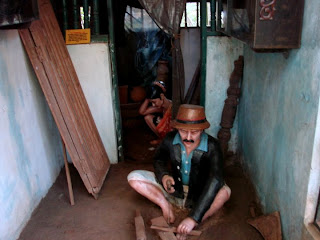Bhaja caves are a ancient Hinayana Buddhist cave monastery excavated sometime from 2nd cen BC to 1st cen AD. They are located atop a mountain alongside the base village of Bhaja (from which the caves get their name or perhaps vice versa) in Maval khore region around 2kms from Malavli railway station near Lonavala (64kms from Pune city).
The caves can be accessed by climbing a series of steep stone steps (which can be covered in half an hours time).
The caves were a part of the highway connecting the ancient trade ports of Kalyan and Sopara.
Traders often used these caves for a stopover before proceeding to the ports and back.
Bhaja caves are also in proximity (5kms away) to the famous Karla caves (Note: ancient name of Karla was Veluraka).In fact the architectural style of Karla and Bhaja caves is quite similar.
In vicinity are also the famous forts of Lohagad and Visapur.
Bhaja acted as a great learning centre for Buddhism and also provided accomodation for the residing monks.
Bhaja is a group of 18 caves.
The main cave is a 17x18 mtr
chaityagriha (having a arched horseshoe shaped facade similar to Karla). The main
stupa (3.45 mtr dia) has an apse background with a grooved ribbed ceiling made in timber.
There are
shilalekhs (probably in the
brahmi script) mentioning donor details found in various spaces.
Besides the chaityagrihas there are many
viharas where the monks were lodged. The interiors of the viharas are very simple. They have a stone plinth that probably doubled as a bed and a chair. There is also a water reservoir outside the rooms to provide potable water for the monks.
Pic: Surya
Pic: Indra
Also present is a pillared hall with some beautiful carvings of various deities (
Surya,Indra),
dwarpalas, animals etc.
Then there is cave room that has 14 nos smaller
stupas located inside(5 nos) as well as outside(9 nos) the enclosure. They are said to store relics and ashes of the departed monks.
All in all the Bhaja caves are a tourists delight and a fine specimen for study by visting historians, archaelogists and students.
The best time to visit Bhaja would be in the monsoons (though they can be visited 365 days in a year), where there are cascades all around and the caves themselves are enwrapped with a green blanket.
Text and Photographs : Abhijit Rajadhyaksha










.JPG)
.JPG)
.JPG)









































